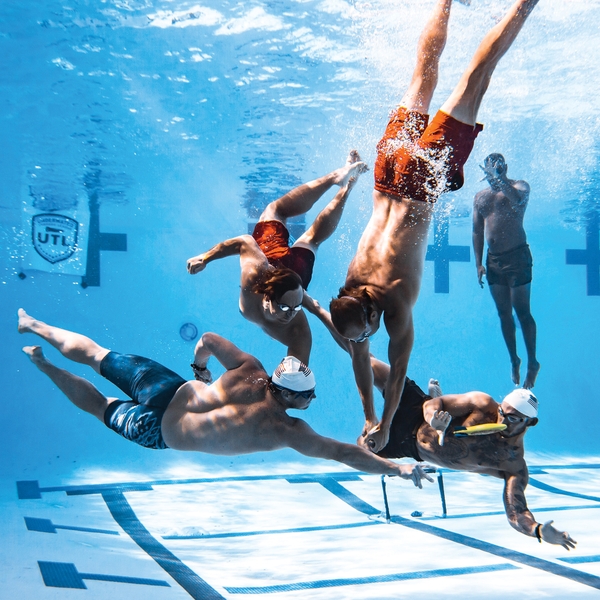The Wild World of the Underwater Torpedo League
The new sport is attracting everyone from NFL players to pro surfers hoping to get an edge in the pool—and on land
New perk: Easily find new routes and hidden gems, upcoming running events, and more near you. Your weekly Local Running Newsletter has everything you need to lace up! .
Sunset Beach, on the North Shore of Oahu, has long been the proving ground for aspiring pro surfers. Growing up in Southern California, Cole Houshmand had heard about its endlessly shifting peaks, territorial locals, and fierce rip current. But nothing prepared him for its punishing impact zone.
Five years ago, Houshmand, then 13 years old, paddled out on a 15-to-20-foot day. About 40 minutes in, he got caught inside the best set that day and had to ditch his board. Diving under the first wave, he was thrashed around like a rag doll for what felt like forever. After six or so upward strokes, he finally popped to the surface, seeing stars, just in time to get one good breath before the next wave��pushed him back down for 20 seconds. He resurfaced, completely out of gas. Still, he had to swim a half-mile to shore��with a broken board, fighting the current.
That pounding loomed in the back of Houshmand’s mind every time he paddled into big surf. When he entered his first full year on the World Surf League’s Men’s Qualifying Series, in 2019—which included stops at powerful breaks like Banzai Pipeline on the North Shore and Cloud Nine��in the Philippines—he knew he needed to shake this distraction and build his mental confidence. Last fall��he saw a social-media post from his friend and professional mixed-martial-arts (MMA) fighter Kailin Curran about the Southern California–based��. Looking at the league’s��, Houshmand was intrigued by photos of athletes grabbing at each other underwater, accompanied by captions like: “Create your calm as you find your focus.” He signed up for a session. “I wanted to be as comfortable in the water as those athletes,” he says. “I felt like training with them could help me in my sport.”
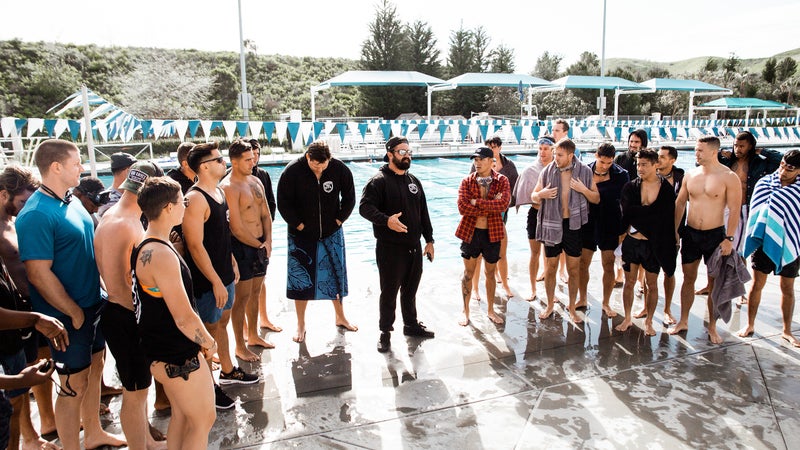
The brainchild of Prime Hall and Don Tran, two former ��(an elite unit of the U.S. Marine Corps), underwater torpedo is played in the deep end of a large pool—ideally 13 to 14 feet deep—by two teams of five. The aim is to get a ten-ounce, ten-inch-long torpedo-shaped toy into a kid’s hockey net anchored at the bottom of the pool by dive bricks. Players may move the torpedo by swimming with it, handing it off, or passing it to another team member, all while submerged. They can surface to take a breath, but not if they are holding the torpedo—that results in a penalty. Tackling, pulling, holding back, and grappling are��only allowed��on the player��in possession of the torpedo. Kicking, punching, choking, and single-limb submissions are forbidden. “We had to add that last foul, because we got a lot of MMA fighters who were putting players into weird ankle locks,” explains Tran, 31. Each game has a referee, and despite the underwater roughhousing, Hall, 35, says there have only been minor injuries, thanks in part to the fact that fins are also forbidden, so players move with less momentum. “That means less impact when players collide,” he��says. A typical match, says Tran, lasts until a��team��scores five goals,��or about ten��minutes, with 30 seconds between each match��to regroup. Games are played in a best-of-three-matches format.
Hall and Tran have each spent nearly a decade learning to remain calm in dangerous underwater situations. In 2009, Hall attended a grueling��three-week course at the Marine Corps Water Survival School, which less than 50 percent of enrollees complete. After graduating, he��went on to certify combat water-safety swimmers—essentially��the lifeguards of the Marine Corps. He trained Tran at Camp Pendleton in California in 2010, and the men went on to attend Marine Special Operations School together, where they were introduced to the game of underwater football. “It’s a bit of an underground sport in the military, played by Marines, Navy SEALs, and Navy divers,” says Tran. “And it is exactly what it sounds like. You’re tackling each other underwater, trying to get a ball through a goal.” The game was originally developed in the 1960s by Dave Murdoch, a scuba instructor at the University of Manitoba, as a way to teach scuba divers to remain relaxed during emergencies, says Keith Peters, the university’s chair of underwater sport. While traditionally played with snorkels, swim fins, masks, and a round��negatively buoyant ball, the military-adapted version ditches the fins and snorkel and uses a hydrodynamic, Nerf-like football. Hall says the game was a fun way to apply lessons learned during water-survival training, including breath holds and how to handle struggling rescue victims. “It’s easier to stay calm underwater when you focus the mind on something other than the lack of air—in this case, a ball,” he says.
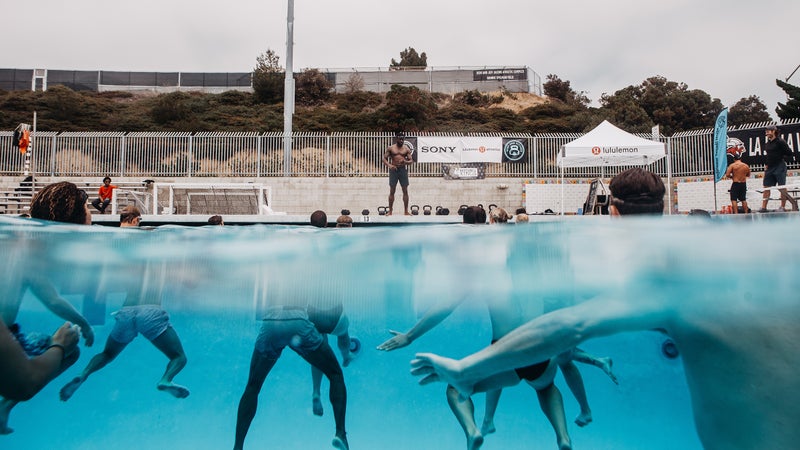
After Hall and Tran left��the Marine Corps in 2017, they began to casually organize underwater-football-inspired games at two pools in Southern California. Social-media posts garnered so much interest that they expanded to more pools soon after, formalized the rules, and changed the name to underwater torpedo to differentiate themselves from underwater football clubs��. By the end of 2017, the Underwater Torpedo League had 12 players and hosted its first league championships, named the Aqua Bowl.
Hall says the game primarily attracts active military members and veterans, MMA fighters, CrossFit enthusiasts, surfers, lifeguards, freedivers, former collegiate swimmers, and water-polo players. “Obviously, having some water experience gives you an advantage,” adds Tran. “We have a former world champion synchronized swimmer who can manipulate her body like no other in the water.” But underwater torpedo has also been a popular off-season training activity for��, including Cleveland Browns linebacker Christian Kirksey, Buffalo Bills safety Micah Hyde, and New Orleans Saints linebacker Manti Te’o.��
To a spectator, underwater torpedo can appear to be a subaquatic free-for-all. Houshmand, a lifelong waterman, says his first experience kicked his butt. When other players tried to tackle him, he lost his cool and dropped the torpedo. Throughout the game, he constantly had to pop up to the surface for gulps of air. But the more he played, the more he learned that underwater torpedo is as much about strategy as it is technique. Some players head straight to the bottom of the pool when they get the torpedo, eliminating chances of an attack from below. Others use a barrel-roll technique so they’re trickier to grab. Successfully passing and shooting in the water takes practice. “The torpedo changes direction easily, unless you’re super precise,” Houshmand says. “My first throw ended up going backwards.” And while ten minutes may not sound long, it feels like an eternity when you’re taking a single breath between plays. “Games are definitely tiring,” he says. “Your muscles feel the effects of not having oxygen.”
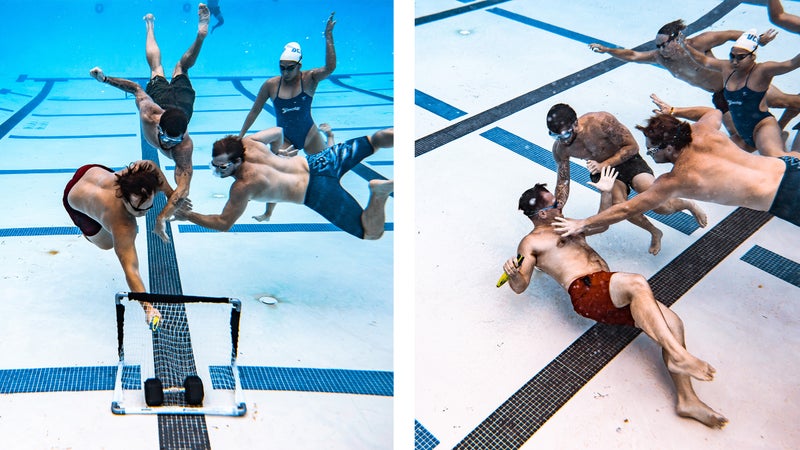
At around the same time they launched the Underwater Torpedo League, Hall and Tran created a complementary training workout called��, which they say builds upon the fundamentals of underwater athletics: focus, relaxation, economy of motion, and efficient breathing. The program currently has seven locations in Southern California, one in Miami, and one in Oahu. Land-based breathing exercises like box breathing (holding each inhale and exhale, and pausing��between them for a count of four) are a key element of every Deep End workout. In her forthcoming book��Breathing for Warriors, Belisa Vranich, a clinical psychologist and breathwork coach, explains that training respiratory muscles can help people tap into energy reserves when fatigue sets in. Most humans have evolved to breathe vertically from the chest and shoulders��rather than horizontally from the diaphragm, the large muscle below the lungs, she says. Deep End Fitness trains its athletes to use diaphragmatic breathing, or belly breathing, a technique that, according to Vranich, can help turn off the fight-or-flight mode triggered by stress. Breathing in and out from the diaphragm also allows us to take in more air, she explains, and��slowing down inhalations��and exhalations oxygenates us better and lowers��our��heart rate, conserving energy.
Deep End Fitness also integrates partnered static and dynamic breath-hold work in the pool, similar to freediving training techniques. Drills resemble surfer Laird Hamilton’s����and might include walking across the bottom of the pool while carrying dumbbells and a person holding onto your shoulders.
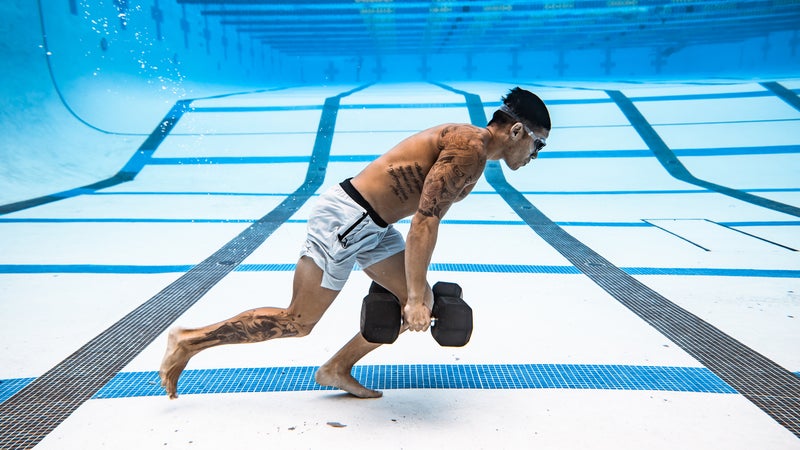
While research��has��shown that breath training can improve athletic performance, there are few studies that have examined whether underwater training translates to performance gains on land. Keith Baar, a professor of molecular exercise physiology at the University of California at Davis and a former strength and conditioning coach for the University of Michigan football team, says the benefits are most likely more mental than physiological. “The ability to deal with the stress and discomfort of not being able to breathe could translate to keeping calm in stressful situations in your sport,” he says, noting that for bigger athletes, such as football players, the low impact of underwater workouts is an added benefit. “And there is evidence that when you train with high-level athletes, you end up pushing yourself harder,” he says.
Currently, the Underwater Torpedo League has 49 players on four teams, ranging from the league’s minimum age, 18,��to 48. Hall and Tran plan��to expand to Australia and Asia this year; once the game is on three continents, they can submit an application for underwater torpedo to become an Olympic demonstration sport. Hall hopes to have it officially accepted by the 2028 Summer Games in Los Angeles.
For now, Houshmand says he plans to keep his Olympic dreams focused on surfing. While he enjoys underwater-torpedo��games, he says he can credit most of his athletic progress to working one-on-one with Tran twice a week in the pool—he finished the 2019 tour ranked 78th out of 1,295 athletes. “The fitness portion hones the mental water confidence,” Houshmand says. “Before, my static breath hold was one��minute and 45 seconds. After a few sessions, I was at two��minutes and 45 seconds.” That extra minute can mean life or death in the ocean, he says.
